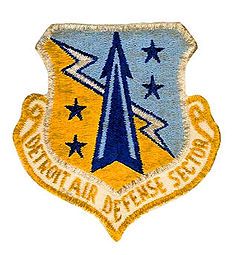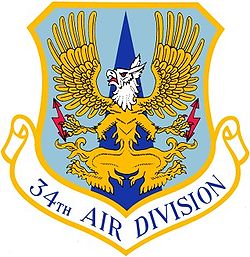
Custer Air Force Station
Encyclopedia


United States Air Force
The United States Air Force is the aerial warfare service branch of the United States Armed Forces and one of the American uniformed services. Initially part of the United States Army, the USAF was formed as a separate branch of the military on September 18, 1947 under the National Security Act of...
General Surveillance Radar station. It is located 5.3 miles (8.5 km) west-northwest of Battle Creek, Michigan
Battle Creek, Michigan
Battle Creek is a city in the U.S. state of Michigan, in northwest Calhoun County, at the confluence of the Kalamazoo and Battle Creek Rivers. It is the principal city of the Battle Creek, Michigan Metropolitan Statistical Area , which encompasses all of Calhoun county...
. It was closed in 1965.
History
Custer Air Force Station was one of twenty-eight stations built as part of the second segment of the Air Defense Command permanent radar network. Prompted by the start of the Korean WarKorean War
The Korean War was a conventional war between South Korea, supported by the United Nations, and North Korea, supported by the People's Republic of China , with military material aid from the Soviet Union...
, on July 11, 1950, the Secretary of the Air Force asked the Secretary of Defense for approval to expedite construction of the permanent network. Receiving the Defense Secretary’s approval on July 21, the Air Force directed the Corps of Engineers to proceed with construction.
Established at Fort Custer, Michigan on 18 April 1953, the 781st Aircraft Control and Warning Squadron began operations with AN/FPS-3 and AN/CPS-4 radars at the site in April 1952. Initially the station functioned as a Ground-Control Intercept (GCI) and warning station. As a GCI station, the squadron's role was to guide interceptor aircraft toward unidentified intruders picked up on the unit's radar scopes.
The site was re-designated Custer Air Force Station on 1 July 1956. An AN/FPS-4 replaced the AN/CPS-4 in 1956 and an AN/FPS-6 superseded this unit two years later. Also in 1958 an AN/FPS-20 replaced the AN/FPS-3 search radar. This radar was upgraded to an AN/FPS-66 in 1961. A second height-finder radar was installed in 1959. On 31 July 1963, the site was redesignated as NORAD ID Z-67.
In 1958 a Semi Automatic Ground Environment
Semi Automatic Ground Environment
The Semi-Automatic Ground Environment was an automated control system for tracking and intercepting enemy bomber aircraft used by NORAD from the late 1950s into the 1980s...
(SAGE) Data Center (DC-06) was established at Custer AFS (Fort Custer). The SAGE system was a network linking Air Force (and later FAA) General Surveillance Radar stations into a centralized center for Air Defense, intended to provide early warning and response for a Soviet nuclear attack. DC-06 was co-located on the Cantonment area of the 781st Radar Squadron.
During 1959 the 781st AC&WS joined the SAGE system, feeding data to DC-06. After joining, the squadron was re-designated as the 781st Radar Squadron (SAGE) on 1 September 1959. The radar squadron provided information 24/7 the SAGE Direction Center where it was analyzed to determine range, direction altitude speed and whether or not aircraft were friendly or hostile.
In addition to the main facility, Custer AFS operated the following AN/FPS-18 Gap Filler sites:
- Midland, MI (P-67A/P-20G) 43°38′03"N 084°25′42"W
- Richland Center, IN (P-67B/P-73J) 41°07′05"N 086°14′28"W
- Saugatuck, MI (P-67C/P-34G) 42°39′44"N 086°12′33"W
- Shelby, MI (P-67D/P-34B) 43°36′00"N 086°20′25"W
DC-06 It was initially under the Detroit Air Defense Sector
Detroit Air Defense Sector
The Detroit Air Defense Sector is an inactive United States Air Force organization. Its last assignment was with the Air Defense Command 26th Air Division, being stationed at Custer Air Force Station, Michigan...
(DeADS), established on on 8 September 1958. The sector was inactivated on 1 April 1966, and re designated as the 34th Air Division. DC-06 with its AN/FSQ-7
AN/FSQ-7
The AN/FSQ-7 was a computer model developed and built in the 1950s by IBM in partnership with the US Air Force. Fifty-two were built and used for command and control functions for the Semi Automatic Ground Environment air-defense system...
computer remained under the 34th AD until it, and the Air Division was inactivated on 30 September 1969 when technology advances allowed the Air Force to shut down many SAGE Data Centers.With the inactivation of the DADS, Custer AFS was inactivated. The 781st RADS ws Discontinued on 25 June 1965
Today the site appears to be a light business office park along with being the headquarters of the 24th NORAD Division. The large SAGE DC-06 blockhouse remains, now being a security archives warehouse. There is also a sign on the perimeter fence for a construction trucking company. The buildings in the immediate area of the SAGE blockhouse are in generally good repair, with some still in use. The Battle Creek regional chapters of the Air Force Sergeant's Association and Air Force Enlisted Association use the old Open Mess building.
Air Force units and assignments
Units:- 4627th Air Defense Wing, 8 January 1957
- Redesignated: Detroit Air Defense SectorDetroit Air Defense SectorThe Detroit Air Defense Sector is an inactive United States Air Force organization. Its last assignment was with the Air Defense Command 26th Air Division, being stationed at Custer Air Force Station, Michigan...
, 1 September 1958 - Redesignated: 34th Air Division (Air Defense), 1 April 1966-31 December 1969
- 781st Aircraft Control and Warning Squadron, activated 16 April 1951 at Fort Custer, MI
- Station re-designated as Custer AFS, 1 July 1956
- Re-designated 781st Radar Squadron (SAGE), 1 September 1959
- Discontinued on 25 June 1965
Assignments:
- 541st Aircraft Control and Warning Group541st Aircraft Control and Warning GroupThe 541st Aircraft Control and Warning Group is a disbanded United States Air Force unit. It was last assigned to the 30th Air Division, stationed at Selfridge Air Force Base,Michigan...
, 16 April 1951 - 30th Air Division, 6 February 1952
- 4706th Defense Wing, 16 February 1953
- 4708th Defense Wing, 1 November 1953
- 30th Air Division, 8 July 1956
- Detroit Air Defense SectorDetroit Air Defense SectorThe Detroit Air Defense Sector is an inactive United States Air Force organization. Its last assignment was with the Air Defense Command 26th Air Division, being stationed at Custer Air Force Station, Michigan...
, 1 April 1959
- 785th AC&W assigned to: DADS
- DADS assigned to: 30th Air Division
- 26th Air Division, 4 September 1963 – 1 April 1966
- 785th Radar Squadron remained under DADS until 25 June 1965
- First Air ForceFirst Air ForceThe First Air Force is a numbered air force of the United States Air Force Air Combat Command . It is headquartered at Tyndall Air Force Base, Florida....
, 1 April 1966 – 31 December 1969
- First Air Force

